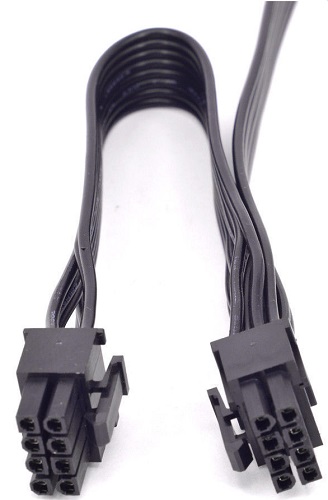Common Issues/Questions
- Should I use PCIe pigtails for my graphics card?
- The advice to not use pigtails is based on the assumption of worst-case scenario and should not be a blanket recommendation.
The “weak link” in a cable is the terminal and not the wire gauge. The most commonly used 18g Mini-Fit terminals support 6A each. Some better PSUs use 16g HCS (High Current System) which supports 10A each terminal. Only 8.5A each if 18g wire is used (a significant drop).
Since most PCIe cables only have 6 terminations on the PSU side (because the difference between the 6-pin PCIe and the 8-pin PCIe are a pair of grounded sense wires and not two wires that actually carry power), 3 being 12V and 3 being ground, the math can be done as so:
For 16g HCS:
3 x 10A = 30A. 30A * 12V = 360W
For 18g HCS:
3 x 8.5A = 25.5A. 25.5A * 12V = 306W
For 18g mini-fit jr terminals:
3 x 6A = 18A. 18 x 12V = 216W
Of course, that is assuming a nominal voltage of +12V. Realistically, the voltage is lower at the load and will drop as the load increases. So it is wise to take a -5% voltage drop into consideration when calculating worst case scenario.
For 16g HCS:
3 x 10A = 30A. 30A * 11.6V = 348W
For 18g HCS:
3 x 8.5A = 25.5A. 25.5A * 11.6V = 295.8W
For 18g mini-fit jr terminals:
3 x 6A = 18A. 18 x 11.6V = 208.8W
So, if your cables are using 16g wires and terminals, using one cable with a pig tail is perfectly fine for even a 600W GPU; nevermind a 450W GPU. However, if 18g or thinner wires are used, the safe bet is to just use one connection on the load side for each available connector.
Most reviews by Aris Bitziopoulos have wire gauge reported in them. If you can find your PSU in a review, check the wire gauge table in the review. If not, when in doubt, opt for not using pig-tails.
 A pigtail cable is a cable with two connectors daisy chained on the load end of the PSU
A pigtail cable is a cable with two connectors daisy chained on the load end of the PSU
- The advice to not use pigtails is based on the assumption of worst-case scenario and should not be a blanket recommendation.